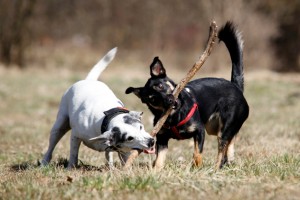Common Mistakes at the Dog Park


Dog Park Dos and Don'ts
Visiting the dog park is a positive experience for a lot of dogs and their owners. However, it can also be stressful or even dangerous when dog owners aren’t paying attention to their dogs or aren’t picking up on their dogs’ signals.
I asked two professional dog trainers to share some of the most common mistakes dog owners make at dog parks. Hopefully the rest of us can try to avoid these errors and set our dogs up for success.
Common mistakes at the dog park
Mistake #1: Assuming your dog enjoys the dog park.
Some people feel pressure to bring their dogs to the dog park because it seems like the right thing to do, said professional dog trainer Robert Haussmann, founder of Dogboy Inc. in New York.
“Many dogs are not comfortable around unknown dogs and can become fearful or aggressive,” he said.
Other dogs are just a bit too intense or tend to bully the others, he said.
“You should know your dog well enough to follow his or her lead on this. If she is not having a good time, I would recommend finding another creative way to expel her energy.”
Mistake #2: Not paying attention to your dog.
Sometimes dogs will act inappropriately when their owners aren't paying attention, said professional dog trainer Andrew Horan, owner of Citizen K9 in Virginia.
“Owners come in, turn their dog loose and then bury their face in either their cell phone or a book,” he said.
He has seen plenty of altercations between owners because one of them was completely oblivious to what the dog was doing.
Mistake #3: Chasing your dog around repeating the command “come!”
The problem with this, according to Haussmann, is that it teaches the dog that ignoring you will result in a “treat-frenzied game of chase” and coming when called will result in leaving the park and “ending the party.”
To prevent this, he said dog owners should teach their dogs to respond to verbal cues before they take their dogs to the park. Dogs should have a good history of positive experiences for coming when called.
Mistake #4: Using the dog park as the dog’s only exercise.
“Dog parks should be a reward for your dog, not used as the only source for exercise,” Horan said. “Dogs that do not get regular exercise get stir crazy.”
He said this pent-up energy can cause the dog to be incapable of controlling himself and could cause the dog to act inappropriately when released “into a sea of other dogs.”
In other words, take your dog for a long walk and then visit the dog park.
Tips to make the dog park a positive experience
Tip #1: Begin socializing your puppy.
Haussmann said dog owners should make sure to socialize their puppies by looking into local puppy socialization groups with certified professional trainers. He also said to introduce your puppy to as many people and dogs as possible.
He said once the pup is around 4 months old and has had lots of fun experiences with other dogs, you could try visiting the dog park during a quieter time with a handful of other dogs around.
Tip #2: Shop around for the best dog park.
“Just because there is a dog park right around the corner from your house, doesn't mean you have to use it,” Horan said. “If you are set on visiting a dog park with your dog, shop around. Each one has its own dynamic, and you may find that you and your dog fit in better elsewhere.”
Tip #3: Know your dog’s social comfort level.
If your dog is already an adult, Haussmann said you should try to gauge her comfort level. Often, a dog may be overwhelmed at the park if she has had limited experiences or negative experiences with other dogs.
He said to make sure your dog is not bullying other dogs or being bullied, and to start with shorter visits during quieter times.
Also, if you feel like something just isn’t right at the park, Horan said it’s best to trust your gut and leave.
“There are always those problem dogs and owners that frequent local dog parks,” he said. “If you see them, opt for a long walk instead.”
Tip #4: Familiarize yourself with canine body language.
“A wagging tail doesn't always mean happy,” Haussmann said. “Yawning doesn't always mean tired, and growling doesn't always mean aggressive.”
He said to check out credible web sites such as the ASPCA and the Association of Pet Dog Trainers for good info on dog body language.
Do you visit the dog park with your dog? What are your tips for making it a positive experience?
Also see our post on safety tips for the dog park.
Explore Popular Articles
-
Homemade Flea, Tick & Mosquito Repellent for Dogs: A Natural Recipe for Pet Parents
Jun 13, 2025Beyond the Buzz and Itch: Protecting Your Pup from Mosquitoes, Fleas, and Ticks As pet parents, we w
-
Can My Dog Eat This? A List of Human Foods Dogs Can and Can't Eat
Jun 04, 2025As loving dog owners, we consider our furry companions members of the family. They share our homes,
-
How Long Are Dogs Pregnant - Tips for Care & Safety
May 15, 2025Congratulations! If you’re reading this, your furry friend is likely expecting a litter of pup




